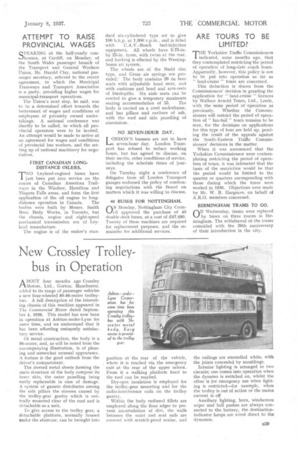New Crossley Trolley bus in Operation
Page 43

If you've noticed an error in this article please click here to report it so we can fix it.
A BOUT lour months ago Crossley .1-111otors, Ltd., Gorton, Manchester, added to its range of passenger vehicles a new four-wheeled 50-56-seater trolleybus. A full description of the interesting chassis of this machine appeared in The Commercial Motor dated September 4, 1936. This model has now been in operation at Ashton-under-Lyne for some time, and we understand that it has been affording eminently satisfactory service.
Of Metal construction, the body is a .56-seater, and, as will be noted from the accompanying illustration, is of pleasing and somewhat unusual appearance. A feature is the good outlook from the driver's compartment.
The riveted metal sheets forming the main structure of the body compose its inner skin, the outer panelling being easily replaceable in case of damage. A system of gussets distributes among the side pillars the stresses caused by the trolley-gear gantry which is centrally mounted clear of the roof and is detachable as a unit.
To give access to the trolley gear, a detachable platform, normally housed under the staircase, can he brought into position at the rear of the vehicle, where it is reached via the emergency exit at the rear of the upper saloon. From it a walking platform fixed to the roof can be reached.
Dry-spot insulation is employed for the trolley-gear mounting and for the radio-interference coils on the trolley gantry.
Within the body radiused fillets are employed along the floor edges to prevent accumulation of dirt, the walls betweea the waist and seat rails are covered with scratch-proof rexine, and the ceilings are enamelled white, with the joints concealed by mouldings.
Interior lighting is arranged in two circuits; one comes into operation when the dynamo is switched on, whilst the other is for emergency use when lighting is restricted—for example, when the trolley is out of action or the mains current is off Auxiliary lighting, horn, windscreen wiper and bell pushes are always connected to the battery, the destinationindicator limps are wired direct to the dynamos.




























































































